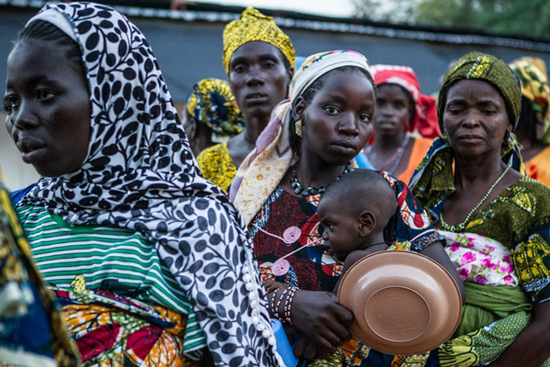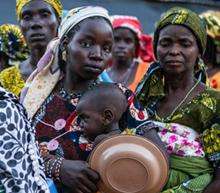In this article, originally published on the Huffington Post, MSF pediatrician Susan Shepherd discusses the reduction of childhood mortality in Niger and strategies to reduce it worldwide.

Niger 2012 © Tanya Bindra
Mothers and children queue to receive food as part of treatment in Guidan Roumdji, where MSF treats malnutrition and malaria.
This article originally appeared on the Huffington Post.
Running your infant to the pediatrician for a well-baby check up and shots may seem like just another chore. Who do you know who ever had measles? Many parents wonder if all those shots are really necessary in the first place. But last week, mothers, nurses, and doctors in Niger reminded me just how powerful and important these simple gestures are.
I'm just back from Madarounfa, the southern-most district in central Niger where Doctors Without Borders/Médecins Sans Frontières (MSF) has worked for more than a decade. Yes, we still treat too many malnourished children and care for those ill with malaria or other common illnesses. But there's a new thing going on. Thousands of mothers and infants cheerfully come to the health center every month for weight checks, immunization updates, and, once the baby reaches six months of age, to receive nutritious baby food as a complement to breastfeeding. As mosquito nets are distributed to the newborns, nurses and mothers engage in lively exchange about how to care for a sick baby and how to feed children so they stay well.
Niger is a land-locked country that straddles the Sahara Desert and the savannah just to the south, known as the Sahel. For most Nigeriens, daily life presents many challenges and struggles. The country has been through three food emergencies in the past six years, and this in a country where the vast majority of its 16 million people work the land to make a living. In 2010, almost half the country's population received some type of short-term economic support in the form of food distribution or cash transfer, and this year the same help is going to about one quarter of all Nigeriens.
But among all this hardship, Nigerien politicians and health professionals are making remarkable progress in child survival. Despite being ranked near the bottom of the UN Development Index, child mortality rates in Niger are in free-fall and dropping twice as fast as its bigger, wealthier neighbor Nigeria. Even with serious economic woes, child malnutrition rates are actually improving. This flies directly in the face of the conventional wisdom that suggests improvement in health indicators only follows economic growth.
So what is happening in Niger? In 1990, Niger had the highest child mortality rate in the world. By the end of the decade, the government started to promote vaccination campaigns along with vitamin A distributions. Between 1998 and 2005 the percentage of children under five who had received a dose of vitamin A went from 7 percent to 75 percent, and the percentage of children vaccinated against measles doubled. Certainly a positive step, but then 2005 happened.
In March of 2005 waves of malnourished and sick children, in numbers never before seen, started flowing through the doors of the MSF hospitals in the south central region of the country. No one understood exactly what was going on, but at that moment there was only time to react. The Ministry of Health quickly approved a national nutrition protocol, UNICEF mobilized, and scores of nongovernmental organizations came into the country, employed many skilled Nigerien doctors and nurses, and set to work treating malnourished children by the tens of thousands. By the end of the year, nearly 100,000 children were helped—60,000 in MSF programs alone. It was, at the time, the largest ever emergency response to severe acute malnutrition.
As it happens many times following crises, a number of very positive changes emerged. Since 2005, more children have been treated for malnutrition in Niger—estimates of over 1 million—than anywhere else in the world. In other words, children in Niger have a better chance of receiving the treatment they need than in any other country in Africa or Asia where malnutrition takes the highest toll.
The Ministry of Health has also conducted at least one health and nutrition survey of children under five every year. Epidemiologic monitoring is simply an indispensable component of any health system. The survey conducted in June 2010 sounded the alarm that prompted major changes to nutrition programming that year and set precedent; for the last three years, a large portion of children under two received nutritional support with novel enhanced nutritional foods during the months preceding the harvest. Studies from an MSF program showed that mortality rates were cut in half when children received quality food supplements tailored to their needs in a program with a high level of adherence and acceptability.
Nutrition and health are inextricably linked: children are more prone to sickness and death if they are malnourished, and vice versa. Malaria in Niger, for example, is a major cause of illness and death, so it is unthinkable to treat children for malnutrition without simultaneously checking for malaria, or distributing insecticide-treated bed nets. Since 2005 the number of cases of malaria treated in children under five has more than tripled, in 2009 reaching more than 1.5 million treated with appropriate medications. Expansion on this scale was possible because national politicians decided that health care must be provided free of charge for children under five and the Global Fund aided with supply of drugs. The percentage of families who have bed nets to sleep under has gone from 0 to 75 percent since 2005.
And, last but not least, vaccinations. Since 2005, the percentage of two-year-olds who have received their complete set of vaccinations has doubled. There is still a ways to go—and children in Niger don't yet benefit from all the protections that immunization provides to children in more developed nations—but this is definitely progress.
Much of this progress was set in motion via decisions made by Nigerien leaders; some of it was accelerated by humanitarian actors and Nigerien health professionals working on the ground. This conglomerate of governmental and emergency aid organizations has laid the groundwork for revitalizing this most important activity: well-baby visits.
Breast-feeding, a healthy diet and treatment for acute malnutrition, completed immunizations, malaria protection and treatment, and good data collection are the backbone of this success. These are the basics of the "moon-shot" moment Dr. Mickey Chopra, chief of health at UNICEF, described in a recent interview, referring to the 47 percent drop in child mortality in Niger over the last 10 years. Yet all this really isn't rocket science. The hard part is figuring out how to keep the system working, because this progress is fragile. While enabled by good policy, a lot of the health gains can be traced to investments by emergency aid organizations, whose funding is neither stable nor predictable. The next critical phase will be integrating the connection between nutrition and health into public health systems and reaching children earlier with interventions that work. It should be about improving children's health as much as an emergency response.
Herein lies the challenge for the Scaling Up Nutrition (SUN) initiative, which aims to curb undernutrition worldwide and whose members met last week at the United Nations in New York. Nigerien mothers and health professionals have done a lot to show this new SUN movement what is possible. Now the question for SUN is what it can do to help consolidate and accelerate these gains in contexts like Niger's. It certainly starts by recognizing how providing nutritionally enhanced supplements to treat and protect children from malnutrition coupled with essential health services are among the most effective interventions that can be rolled out. If Nigerien leaders and the numerous international and national nongovernmental actors are up to the task, who knows how fast this child survival epidemic can pick up speed.
Dr. Susan Shepherd is a pediatrician from Butte, Montana. She has worked for MSF for the last six years and coordinates work in nutrition. She has worked in Uganda, Chad, Niger, Kenya, South Sudan, Burkina Faso, and Ghana.




